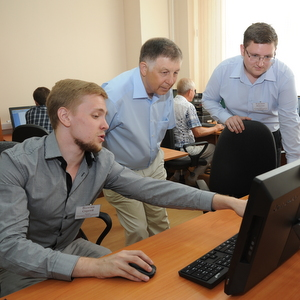
English > News
Young SSAU scientists will guide the orbital constellation of the satellites 'Aist-1' by themselves
24.08.2015, 11:33
The Ground Control Complex for Small Spacecraft of Samara State Aerospace University took control of the satellites “Aist-1”.
Until recently, guidance of the students’ satellites “Aist-1” was carried out by the specialists of JSC “Rocket and Space Centre “Progress” in the Data Reception and Processing Centre (DRPC) “Samara”. The data received from SSAU scientific equipment on board of the satellites “Aist-1” was processed by the engineers of the Rocket and Space Centre and then was transferred to the university scientists.
Since August 2015 Rocket and Space Centre “Progress” has completely handed over the guidance of the devices “Aist-1” to Samara State Aerospace University. Now SSAU scientists and graduate students will perform monitoring of the satellites, make commands on board and perform testing telemetry.
It became possible with opening of the Ground Control Complex for Small Spacecraft (GCC SS SSAU) in the University. The complex includes transmitter, receiver, four automated workstations and antenna arrangement, located on the roof of SSAU scientific complex. SSAU graduate students were previously trained and certified at the Rocket and Space Centre “Progress” to work in the Ground Control Complex for Small Spacecraft.
By means of the Ground Control Complex the young scientists will be able to generate a satellite flight program and put it onboard by themselves, as well as switch on any given scientific equipment at a specified time, obtain information on trajectory parameters, temperature indexes, onboard voltage and current of the solar panels, as well as to carry out a series of other operations.
Currently, the Ground Control Complex for Small Spacecraft changed to a full-time duty mode and holds five sessions with the satellites “Aist” per day, each session lasts from 1 to 12 minutes. The frequency and duration of sessions depends on the location spacecraft relative to the radio visibility zone of the Ground Control Complex antennas.
According to Professor Sergey Tkachenko, Head of SSAU Scientific and Educational Complex of Small Spacecraft, the opportunity to participate in the small spacecraft guidance will allow to attract students and graduate students to scientific researches with the use of the satellites “Aist-1”.
Also, the guidance transfer of the satellites “Aist-1” in SSAU will release technical capabilities the Data Reception and Processing Centre (DRPC) “Samara” to prepare work with the spacecraft “Aist-2”, which is being made by the Rocket and Space Centre “Progress” in conjunction with Samara State Aerospace University, and will be launched within the framework of the first launch campaign from the space-launch complex “Vostochniy”.
For reference
The satellites “Aist-1” are made by SSAU students and engineers of JSC “Rocket and Space Centre “Progress” to meet educational, scientific and technical as well as experimental challenges.
Today, the grouping of two small satellites “Aist-1” successfully works in space.
On April 19, 2013 the first small spacecraft “Aist-1” was launched from the space-launch complex Baykonur together with a research satellite “Bion-M” No. 1. The satellite orbit parameters: height of 575 km and inclination of 64.9 degrees.
On December 28, 2013 the second small spacecraft “Aist-1” was launched by the carrier rocket “Soyuz-2-1v” from the space-launch complex Plesetsk.
The students’ satellites “Aist-1” are identical, but they are in different orbits. The first “Aist-1” flies in the middle latitudes, the second “Aist-1”- at high transpolar orbit at the height of 625 km and inclination of 82.4 degrees.
The creation project of the create small spacecraft “Aist-1” was initiated by a group of students of Samara State Aerospace University named after S. P. Korolev in 2006. Project works and development of the whole scientific equipment complex were carried out by SSAU students and teachers. The Rocket and Space Centre “Progress” was engaged in the satellites manufacturing.
Russian version of news
Russian version of news









